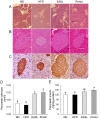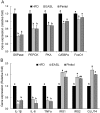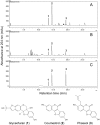Pterocarpan-enriched soy leaf extract ameliorates insulin sensitivity and pancreatic β-cell proliferation in type 2 diabetic mice
- PMID: 25401395
- PMCID: PMC6271205
- DOI: 10.3390/molecules191118493
Pterocarpan-enriched soy leaf extract ameliorates insulin sensitivity and pancreatic β-cell proliferation in type 2 diabetic mice
Abstract
In Korea, soy (Glycine max (L.) Merr.) leaves are eaten as a seasonal vegetable or pickled in soy sauce. Ethyl acetate extracts of soy leaves (EASL) are enriched in pterocarpans and have potent α-glucosidase inhibitory activity. This study investigated the molecular mechanisms underlying the anti-diabetic effect of EASL in C57BL/6J mice with high-fat diet (HFD)-induced type 2 diabetes. Mice were randomly divided into normal diet (ND), HFD (60 kcal% fat diet), EASL (HFD with 0.56% (wt/wt) EASL), and Pinitol (HFD with 0.15% (wt/wt) pinitol) groups. Weight gain and abdominal fat accumulation were significantly suppressed by EASL. Levels of plasma glucose, HbA1c, and insulin in the EASL group were significantly lower than those of the HFD group, and the pancreatic islet of the EASL group had greater size than those of the HFD group. EASL group up-regulated neurogenin 3 (Ngn3), paired box 4 (Pax4), and v-maf musculoaponeurotic fibrosarcoma oncogene homolog A (MafA), which are markers of pancreatic cell development, as well as insulin receptor substrate 1 (IRS1), IRS2, and glucose transporter 4 (GLUT4), which are related to insulin sensitivity. Furthermore, EASL suppressed genes involved in hepatic gluconeogenesis and steatosis. These results suggest that EASL improves plasma glucose and insulin levels in mice with HDF-induced type 2 diabetes by regulating β-cell proliferation and insulin sensitivity.
Conflict of interest statement
The authors declare no conflict of interest.
Figures





References
Publication types
MeSH terms
Substances
LinkOut - more resources
Full Text Sources
Other Literature Sources
Medical

